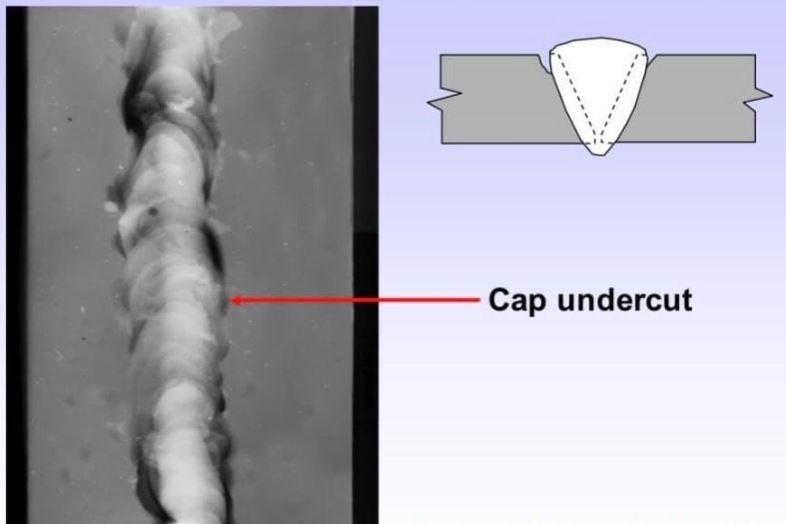Specialist Approaches for Preventing Weld Undercut Effectively
Specialist Approaches for Preventing Weld Undercut Effectively
Blog Article
Understanding the Causes and Solutions for Undercut Welding in Metal Construction Processes
In the realm of metal fabrication processes, the occurrence of undercut welding positions a considerable difficulty that demands a detailed understanding of its causes and practical options. The complex interplay of different elements during welding operations can bring about this undesirable sensation, influencing the architectural stability and general quality of the welded joints - Preventing weld undercut. By dissecting the origin of undercut welding and checking out efficient restorative measures, fabricators can boost the criterion of their craftsmanship and guarantee the production of remarkable steel elements
Typical Reasons of Undercut Welding
Frequently neglected in metal construction, undercut welding takes place due to numerous aspects that require meticulous attention and know-how to be properly mitigated. Additionally, incorrect welding methods, such as utilizing the incorrect welding angle or take a trip speed, can also contribute to undercut formation. The choice of welding specifications, such as voltage, present, and cable feed speed, plays a considerable function in the event of undercut welding.
Influence of Incorrect Welding Parameters
Imprecise welding criteria can significantly compromise the integrity and top quality of bonded joints in steel manufacture procedures. The effect of wrong welding criteria shows up in different methods, resulting in structural weaknesses and issues in the bonded elements. One vital aspect affected by inappropriate welding criteria is the infiltration depth of the weld. Insufficient warmth input because of low welding currents or excessively high traveling rates can lead to insufficient fusion in between the base steels, resulting in incomplete joint infiltration and deteriorated bonds. On the other hand, excessive warmth input created by high welding currents or sluggish travel rates can cause too much and burn-through support, creating a weak and unsteady weld structure. In addition, wrong criteria such as incorrect voltage setups or inaccurate electrode angles can add to unpredictable weld bead accounts, lack of blend, and enhanced opportunities of defects like damaging. Meticulous focus to welding parameters is vital to ensure the production of high-grade welds with the wanted mechanical residential properties and architectural integrity.
Effect of Improper Torch Angle
Incorrect torch angle in welding operations can significantly influence the top quality and stability of the final weld joints in metal fabrication processes. Damaging is a typical welding problem where a groove forms along the weld toe, weakening the joint and compromising its architectural stability.
A lantern angle that is also steep can result in insufficient infiltration, insufficient combination, and enhanced spatter. On the other hand, a lantern angle that is as well shallow can result in excessive infiltration, burn-through, and distortion of the base product. Preventing weld undercut. Proper torch angle is crucial for making certain constant weld quality, toughness, and look
To stop undercutting and various other defects created by incorrect torch angles, welders have to be trained to maintain the proper torch angle throughout the welding procedure. Routine monitoring and change of torch angles during welding can aid achieve audio welds with very little defects.
Function of Inadequate Welding Techniques

Another aspect of inadequate welding techniques is improper weld prep work. Poor cleansing of the base steels, inaccurate joint style, or insufficient edge preparation can all add to damage welding. Moreover, inadequate securing gas insurance coverage or making use of the incorrect sort of gas can result in incomplete blend and the development of undercut flaws.
To address the duty of poor welding strategies in steel construction procedures, it is important to offer comprehensive training for welders. Correct education and learning on welding specifications, joint preparation, and securing gas choice can assist avoid undercut welding and make sure high-grade welds in steel construction projects.
Reliable Solutions for Undercut Welding
Attending go to this website to undercut welding in metal manufacture requires implementing efficient solutions to boost weld high quality and architectural stability. Among the main remedies to deal with undercut is to readjust welding specifications such as voltage, current, and travel speed to ensure appropriate warmth input and combination. By fine-tuning these setups, welders can avoid too much melting of the base metal and filler material, reducing the possibility of undercut development.
Additionally, appropriate joint preparation is critical in avoiding undercut. Guaranteeing clean base steel surfaces without contaminants and utilizing the ideal bevel angle can help promote see this site much better weld penetration and minimize the threat of undercut - Preventing weld undercut. Employing appropriate welding strategies, such as oscillating the torch or weaving, can likewise assist in dispersing heat uniformly and filling up the weld joint adequately, reducing the possibility of undercut problems
Moreover, picking the correct welding consumables, including electrodes and filler metals, is vital in minimizing undercut. Making use of materials with appropriate chemical compositions and mechanical residential properties can add to attaining audio welds with marginal undercut. Normal examination and quality assurance measures should also be implemented to spot and deal with undercut problems immediately, making sure the general stability of produced metal parts.

Final Thought
In final thought, comprehending the reasons and services for undercut welding in metal fabrication processes is crucial for achieving high-quality welds. By addressing common reasons such as wrong welding specifications, incorrect torch angle, and poor welding strategies, welders can stop undercutting and ensure solid, long lasting welds. It is necessary to take note of these elements and carry out efficient solutions to boost the general welding process and end product quality.

Report this page